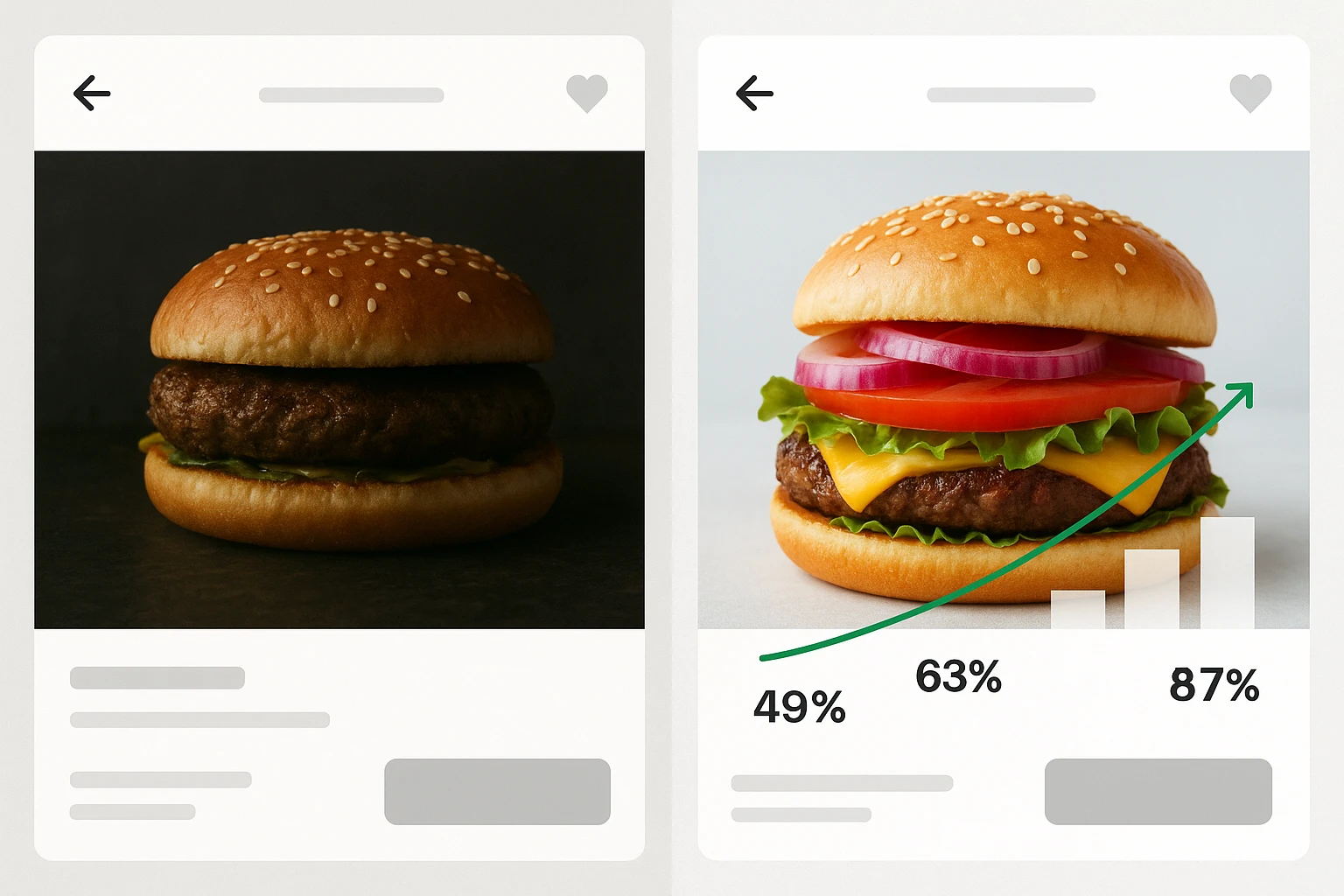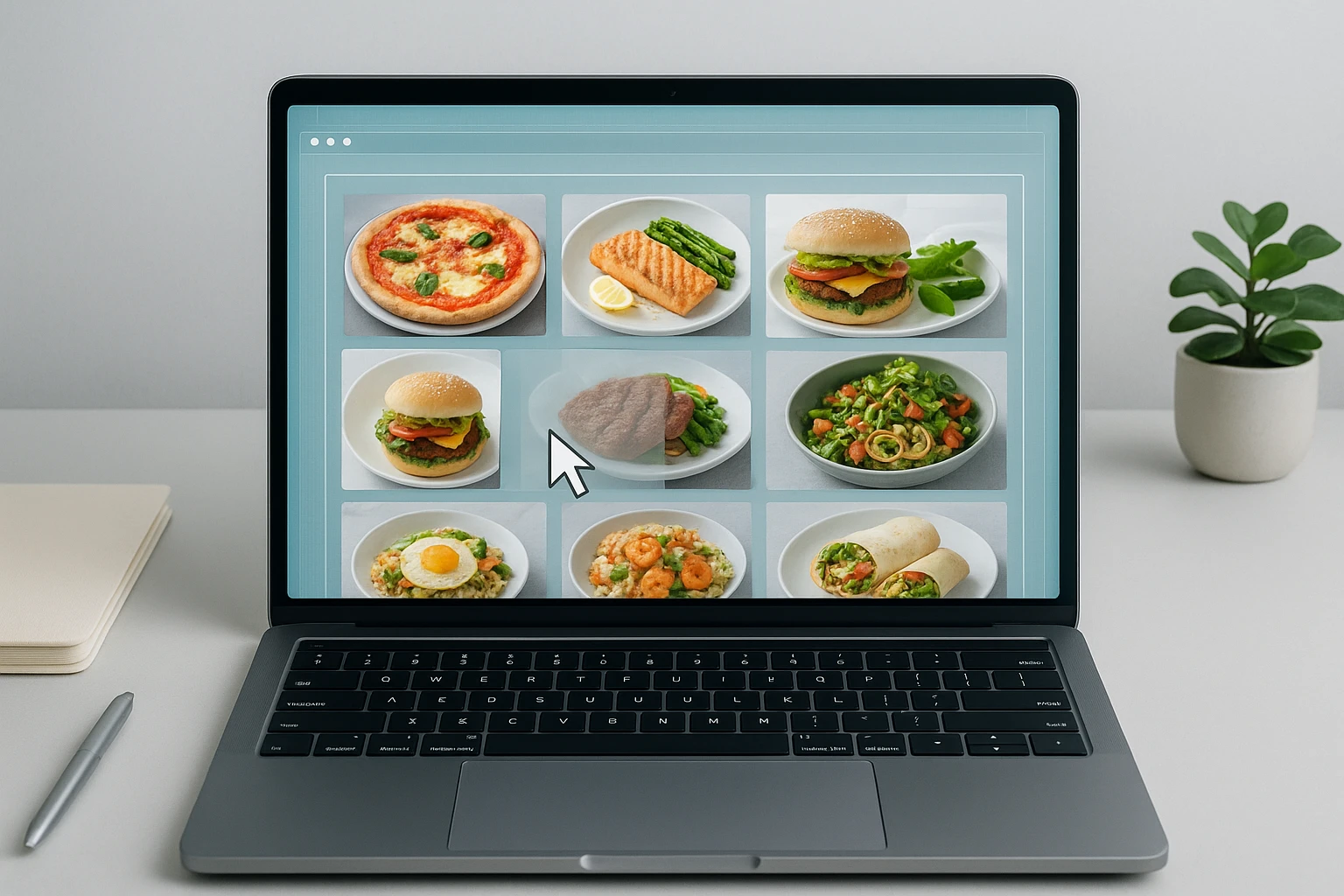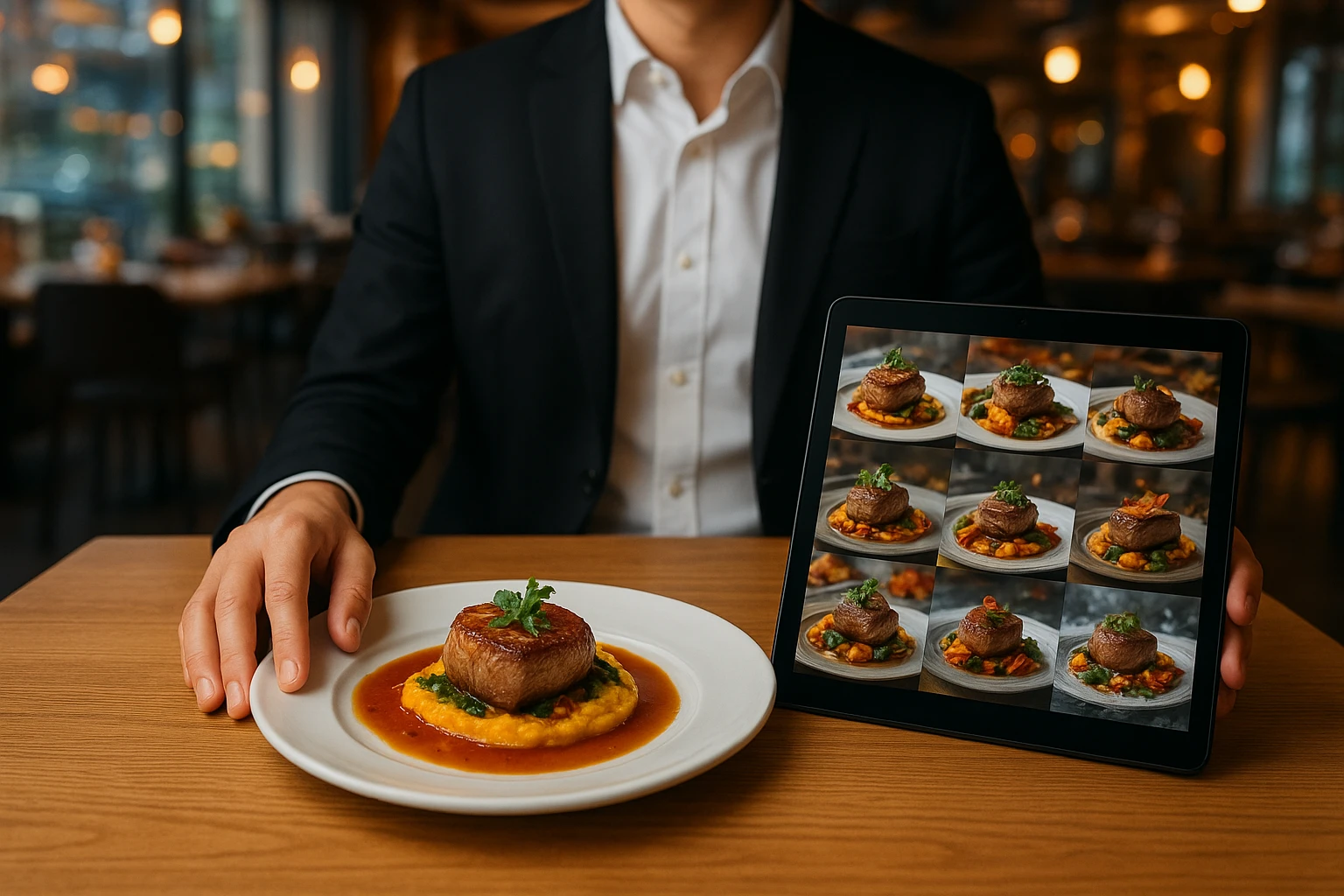The Death of the $2,000 Food Photoshoot

Quick navigation:
- 1. Why the $2,000 food photoshoot is dying (but photography isn’t)
- 2. What still matters: quality, honesty, and conversion in a visual?first marketplace
- 3. Replace the big shoot: a practical, AI?accelerated workflow for operators
- 4. When to still hire a photographer: the hybrid model that actually pencils out
- 5. Turn photos into revenue: connecting visuals, analytics, and future?proof menus
1. Why the $2,000 food photoshoot is dying (but photography isn’t)
From $2,000 Photoshoots to Always-On Menu Imagery
| Old Model: Big Photoshoot | New Model: AI-Accelerated Workflow |
|---|---|
| Budget Pattern | One-off $2-10K shoot, big sunk cost |
| Operational Impact | Close sections, stage props, coordinate staff for a full day |
| Freshness of Photos | Stale within months; reshoot for every packaging or garnish change |
| Data & Iteration | ‘Hope and pray’ creative; decisions based on taste not tests |
| Use Cases Covered | Mostly website + a few hero shots |
A regional group is rolling out delivery to 40 locations. Their agency quotes $18,000 and three full days of disruption for a “must-have” shoot: shut down brunch, haul in lights, stage fake tablescapes. By the time they change packaging or tweak portion sizes, half those restaurant menu photos will already be wrong.
That’s the core problem with the classic $2,000?a?day shoot: it was designed for a world where you updated menu boards once a year and your website had six hero shots. Today you need:
- 3-5 online ordering food photos per dish for delivery tiles, in-app promos, and social.
- Variants for QR menus, catering decks, digital billboards, and third-party marketplaces.
- Rapid refreshes when you change containers, toppings, or price points.
According to McKinsey, digital ordering and delivery were already growing several times faster than dine-in even before recent shocks. That shift multiplied the number of decisions made off a photo instead of a server recommendation.
The risk has flipped
The danger used to be not investing in a big glossy shoot.
Now the bigger risk is being locked into inflexible imagery you can’t test or adapt:
- Photos that show portions you no longer serve, leading to review complaints.
- Perfectly lit burgers that don’t match the current bun, confusing new guests.
- Hero shots that were never tested-just selected because “the chef liked it.”
Delivery platforms are blunt about this. DoorDash’s menu photo guidelines stress that accurate, appetizing photos help guests decide quickly and reduce disputes. Deliverect notes that better photos correlate with higher conversion and order value, especially when guests can’t see your dining room.
So photography isn’t dying. The old purchasing pattern is. Operators are shifting from rare, expensive shoots to an always-on system:
- Lightweight staff capture on phones.
- AI food photography for restaurants (via tools like Yummify) to style those captures into consistent, on-brand assets.
- Ongoing testing and refreshes instead of all-or-nothing gambles.
If you treat visuals as a living part of menu engineering, you spend less overall-and your photos finally keep up with your operation.
Pause and list where your current food photos came from and how old they are-this will anchor the rest of the article in your real numbers.

2. What still matters: quality, honesty, and conversion in a visual?first marketplace
Cheaper workflows do not mean you can relax your standards. If anything, the bar for restaurant marketing visuals is higher because every decision happens on a screen.
The three non?negotiables
For any menu image-whether from a DSLR, phone, or Yummify AI workflow-ask:
- Clarity: Can a guest instantly see what they’re getting?
- Honesty: Does it truly match the portion, toppings, and packaging you serve?
- Conversion: Does it make someone more likely to click and build a better basket?
DoorDash’s best practices and Uber Eats’ photo tips both emphasize the same technical basics:
- Bright, even lighting (window or diffused) with no harsh shadows.
- A clear view of the hero item-no heavy filters, no tight crops hiding ingredients.
- Simple, non-distracting backgrounds and props.
Deliverect reports that strong online ordering food photos can significantly improve click-through and basket size, especially on crowded delivery platforms. Numbers vary by market, but the pattern is consistent: better images, better revenue.
Operator checklist: modern photo standards
Use this quick checklist against three of your current hero shots:
- The main dish is fully visible, sharp, and well lit.
- Colors look appetizing but not neon or plastic.
- Portions in the photo match what guests receive today.
- At least one angle clearly shows key ingredients and toppings.
- Backgrounds support the dish without stealing attention.
- No hidden cheese on “vegan,” no croutons on “gluten?free,” no mystery sauces.
- File sizes and ratios work for delivery tiles, QR menus, and your website.
This is where AI food photography for restaurants needs guardrails. Yummify starts from your real dish photo or description and styles around it-so you can dial in plating, background, and lighting-while keeping portions and components recognizable. Pair that with clear allergen/dietary rules (for more depth, see our guide to honest imagery for allergens and dietary claims).
For visual inspiration on plating and composition, watch this short clip and notice how simple changes in angle and garnish change the story of the dish:
Compare three of your current hero images against this checklist and note where they fall short-those gaps are where low-cost improvements will pay off fastest.

3. Replace the big shoot: a practical, AI?accelerated workflow for operators
Instead of saving up for an annual blowout shoot, treat photography like inventory: small, frequent runs that match demand. Here’s a Yummify-style workflow you can plug into a typical week.
Step 1: Capture while you prep
Ask one line cook or shift lead to shoot 3-5 angles of each featured item during prep, not peak service:
- Place the dish near a window or under your best overhead light.
- Shoot overhead, 45?, and a close side angle showing layers or fillings.
- Grab at least one shot in the actual to?go packaging.
This takes 5-10 minutes per dish if you make it a habit. For deeper habits and shot lists, see our guide on simple capture habits for better AI results.
Step 2: Run through a Yummify AI workflow
At the end of the shift, your marketer or GM selects the best captures and uploads to Yummify:
- Apply a saved branded environment (for example, “Bright Taqueria” or “Modern Bento”).
- Let prompt enhancement add detail you’d never have time to type yourself.
- Generate 3-6 variations per hero dish at standard quality.
According to McKinsey, delivery is one of the fastest-growing channels in food service; that alone justifies having multiple, testable restaurant marketing visuals for each core item.
Step 3: Publish and test across channels
Within an afternoon, you have a full set of consistent restaurant menu photos ready to:
- Upload to delivery platforms and your own online ordering site.
- Drop into QR menus (see our best practices for QR menus that convert).
- Reuse in social posts, email headers, and in?store screens.
Start basic A/B tests on key dishes (thumbnail A vs B for two weeks each). Our guide to A/B testing food photos walks through timelines and metrics.
Sketch this five-step workflow for your own operation and jot down who would realistically own each step next quarter.

4. When to still hire a photographer: the hybrid model that actually pencils out
AI food photography for restaurants doesn’t replace photographers; it changes when you need them.
Where pros still earn their fee
You should absolutely consider a photographer when:
- Launching or rebranding a concept and you need iconic hero imagery.
- Opening a flagship where PR, influencers, and reviewers will judge you off your visuals.
- Shooting complex motion or people-heavy scenes (bartenders in action, lifestyle spreads).
In those cases, negotiate a scope that feeds your AI system:
- Capture clean, well-lit plates on neutral backgrounds along with styled scenes.
- Ask for overhead and 45? angles you can later feed into Yummify for seasonal or localized variants.
Quick decision matrix
Use this simple matrix the next time an agency says “we need a full reshoot”:
- Brand launch or major rebrand -> Hybrid: pro heroes + Yummify variants.
- New flagship opening -> Hybrid: half-day shoot + AI for menus and QR.
- Everyday LTOs, add-ons, or sides -> AI-first with staff capture.
- Packaging or portion tweaks -> AI-first update using new container shots.
- Catering catalog refresh -> Hybrid: a few anchor trays + AI to generate layouts for different group sizes (see our guide on AI-styled catering platters).
This hybrid approach keeps photographers focused on what humans do best-art direction, storytelling, complex lighting-while Yummify handles volume, consistency, and rapid change.
List your next 3-5 big marketing moments and note which deserve a hybrid approach versus pure AI workflows.

5. Turn photos into revenue: connecting visuals, analytics, and future?proof menus
Once your imagery is always-on, the question becomes: which photos actually make you money?
Close the loop between photos and sales
Adopt a simple test-and-learn playbook:
- Tag each image variant in your POS or menu management tool (e.g., “BURGER_A”, “BURGER_B”).
- Run each variant for 2-4 weeks on a single channel at a time.
- Track item-level metrics: impressions, click-through, conversion to order, and average check size.
- Keep the winner and retire the loser.
Research from McKinsey shows digital ordering is increasingly central to restaurant revenue, which means even small gains in conversion stack up over thousands of orders.
Pair that with menu engineering:
- Give high-margin items more visually aggressive angles, props, or serving vessels.
- Test combo shots (burger + loaded fries) versus single-item shots to see which builds better baskets.
- Use winning images from delivery tests on QR menus and your website homepage.
For a deeper dive on the data side, see our playbook on closing the loop between food imagery and sales analytics.
Over time, your Yummify AI workflow becomes less about “pretty pictures” and more about controlled experiments: refresh, test, standardize, repeat. Choose one high-volume item and one underperformer, and commit to testing new visuals for both in the next 30 days.

Next steps
If your last food photoshoot cost more than a weekend’s payroll, it’s probably working against you. Instead of waiting another year to redo everything, run a small pilot: pick 8-12 dishes, capture them on a smartphone during prep, and run them through a Yummify AI workflow to create consistent, testable images. Roll those into one delivery app and your QR menu, then monitor sales for a month. You’ll know very quickly whether an always-on, AI-assisted system can replace your old $2,000 photoshoot-and you’ll have a repeatable process you can scale across every concept and location.
FAQ
Will moving away from big pro photoshoots hurt my brand or reviews?
Not if you replace them with a disciplined, always-on workflow. Guests and reviewers care that photos are appetizing, accurate, and consistent with what shows up at the table or door. DoorDash’s best practices and Deliverect’s guidance both stress clarity and realism over expensive styling. A lean Yummify process can actually improve trust by keeping images aligned with current portions, packaging, and recipes. The key is enforcing internal standards and reviewing top-selling images at least quarterly.
Can AI-styled photos meet delivery app guidelines without getting flagged?
Most delivery platforms focus on what the guest sees-accuracy, clarity, and proper formatting-rather than the specific tools used to produce the image. DoorDash and Uber Eats guidelines emphasize lighting, framing, and avoiding misleading edits. As long as your Yummify outputs truthfully represent your dishes and respect those rules, they should be acceptable. Policies can change, so operators should periodically review platform documentation and keep AI styling aligned with real portions and ingredients.
How do I keep AI-powered photos honest about allergens and dietary claims?
Start with clear, documented rules: what a vegan symbol means, how you show gluten-free, and how you depict common allergens. Make sure whoever runs your Yummify AI workflow tags dishes with those attributes and checks outputs against the rules before publishing. The National Restaurant Association’s State of the Restaurant Industry report highlights rising guest concern about transparency, so this is both a legal and competitive issue. When in doubt, simplify the styling rather than risk misrepresenting cheese, nuts, or bread components. Build a quick signoff step into your process for any item with allergen or dietary labels.
What’s a realistic monthly time and budget to maintain an always-on imagery system?
For a single-location restaurant with a focused menu, expect roughly 2-4 hours a month of staff time: capturing new or changed items during prep, approving Yummify outputs, and updating menus. Budget-wise, many operators can cover ongoing needs with a modest monthly subscription instead of occasional $3,000-$6,000 shoots, but exact tiers depend on how many images and variants you generate. Multi-unit groups may dedicate part of one marketing role (say 4-8 hours a month) to coordinate capture calendars and brand standards. The main shift is moving from large, unpredictable checks to smaller recurring spend tied to real menu changes and campaigns.
How quickly can I see sales impact from new AI-enhanced photos?
If you focus on high-volume items, you can usually see directional results within 2-4 weeks per test on a delivery app or QR menu. Digital channels generate enough impressions that even modest shifts in click-through or conversion become obvious when you compare before/after periods. Research from McKinsey shows digital ordering is a major revenue driver, while Deliverect links better photos to stronger performance, so it’s worth running structured image tests. Start with one or two menu items, hold price and placement steady, and change only the image so you can attribute differences to the visuals.
Do multi-location and franchise concepts need a different approach?
They need more structure, not fundamentally different tools. The playbook usually involves defining a small set of branded environments in Yummify, then rolling those out as templates all locations must use. A central team or approved agency can manage core hero assets, while local operators handle day-to-day capture for LTOs and packaging changes. For more on this, see our guide to AI photos for franchise consistency, which covers governance, approvals, and how to prevent off-brand local improvisations.


